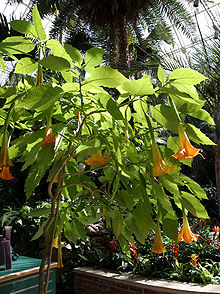Brugmansia
| Brugmansia | |
|---|---|
 |
|
| Brugmansia 'Feingold' | |
| Scientific classification | |
| Kingdom: | Plantae |
| (unranked): | Angiosperms |
| (unranked): | Eudicots |
| (unranked): | Asterids |
| Order: | Solanales |
| Family: | Solanaceae |
| Subfamily: | Solanoideae |
| Tribe: | Datureae |
| Genus: |
Brugmansia Pers. |
| Species | |
|
See text |
|
| Synonyms | |
|
Methysticodendron R.E.Schult. |
|
See text
Methysticodendron R.E.Schult.
Pseudodatura Zijp
Brugmansia is a genus of seven species of flowering plants in the family Solanaceae. They are woody trees or shrubs, with pendulous flowers, and have no spines on their fruit. Their large, fragrant flowers give them their common name of angel's trumpets, a name sometimes used for the closely related genus Datura. (Datura differs from Brugmansia in that they are herbaceous bushes, with erect rather than pendulous flowers - and most have spines on their fruit).
Like many ornamental plants, all parts of Brugmansia can be toxic. All seven species are listed as Extinct in the Wild by the IUCN Red List, although they are popular ornamental plants and still exist wild in other areas as an introduced species.
Brugmansia are large shrubs or small trees, with semi-woody, often many-branched trunks. They can reach heights of 3–11 m (10–36 ft). The leaves are alternately arranged along the stems, generally large, 10–30 cm (4–12 in) long and 4–18 cm (2–7 in) across, with an entire or coarsely toothed margin, and are often covered with fine hairs. The name "angel's trumpet" refers to the large, pendulous, trumpet-shaped flowers, 14–50 cm (6–20 in) long and 10–35 cm (4–14 in) across at the opening. They come in shades of white, yellow, pink, orange, green, or red. Most have a strong, pleasing fragrance that is most noticeable in the evening. Flowers may be single, double, or more.
Brugmansia are native to tropical regions of South America, along the Andes from Venezuela to northern Chile, and also in south-eastern Brazil. They are grown as ornamental container plants worldwide, and have become naturalized in isolated tropical areas around the globe, including within North America, Africa, Australia, and Asia.
Most Brugmansia are fragrant in the evenings to attract pollinating moths. One species lacking scent, the red-flowered Brugmansia sanguinea, is pollinated by long-billed hummingbirds.Brugmansia have two main stages to their life cycle. In the initial vegetative stage the young seedling grows straight up on usually a single stalk, until it reaches its first main fork at 80–150 cm (2.6–4.9 ft) high. It will not flower until after it has reached this fork, and then only on new growth above the fork. Cuttings taken from the lower vegetative region must also grow to a similar height before flowering, but cuttings from the upper flowering region will often flower at a very low height.
...
Wikipedia
